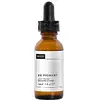What's inside
What's inside
 Key Ingredients
Key Ingredients

 Benefits
Benefits

 Concerns
Concerns

 Ingredients Side-by-side
Ingredients Side-by-side

Water
Skin ConditioningNiacinamide
SmoothingPropanediol
SolventGlycerin
HumectantButylene Glycol
HumectantAcetyl Glycyl Beta-Alanine
Skin ConditioningPotassium Azeloyl Diglycinate
Skin ConditioningCaprylic/Capric Triglyceride
MaskingHexylresorcinol
AntimicrobialEthyl Linoleate
EmollientDiglucosyl Gallic Acid
Glycyrrhiza Glabra Root Extract
BleachingDextran
Nonapeptide-1
Skin ConditioningSodium PCA
HumectantPanthenol
Skin ConditioningSodium Hyaluronate
HumectantProline
Skin ConditioningHydroxyproline
Skin ConditioningXanthan Gum
EmulsifyingLecithin
EmollientSclerotium Gum
Emulsion StabilisingPullulan
Silica
AbrasiveChlorphenesin
AntimicrobialPhenoxyethanol
PreservativeEthylhexylglycerin
Skin ConditioningCaprylyl Glycol
EmollientSodium Hydroxide
BufferingSodium Gluconate
Skin ConditioningWater, Niacinamide, Propanediol, Glycerin, Butylene Glycol, Acetyl Glycyl Beta-Alanine, Potassium Azeloyl Diglycinate, Caprylic/Capric Triglyceride, Hexylresorcinol, Ethyl Linoleate, Diglucosyl Gallic Acid, Glycyrrhiza Glabra Root Extract, Dextran, Nonapeptide-1, Sodium PCA, Panthenol, Sodium Hyaluronate, Proline, Hydroxyproline, Xanthan Gum, Lecithin, Sclerotium Gum, Pullulan, Silica, Chlorphenesin, Phenoxyethanol, Ethylhexylglycerin, Caprylyl Glycol, Sodium Hydroxide, Sodium Gluconate
Lentinus Edodes Mycelium Extract
Skin ConditioningWater
Skin ConditioningGlycerin
HumectantPropanediol
SolventPotassium Azeloyl Diglycinate
Skin ConditioningButylene Glycol
HumectantAcetyl Glycyl Beta-Alanine
Skin ConditioningMyristoyl Nonapeptide-3
Skin ConditioningTetrapeptide-30
Skin ConditioningOligopeptide-68
BleachingDiglucosyl Gallic Acid
Evodia Rutaecarpa Fruit Extract
Skin ConditioningAlgae Extract
EmollientGlycine Soja Oil
EmollientHydrogenated Lecithin
EmulsifyingSodium Oleate
CleansingDisodium EDTA
Trisodium Ethylenediamine Disuccinate
Pentylene Glycol
Skin ConditioningDimethyl Isosorbide
SolventEthoxydiglycol
HumectantPolysorbate 20
EmulsifyingPotassium Sorbate
PreservativeSodium Benzoate
Masking1,2-Hexanediol
Skin ConditioningPhenoxyethanol
PreservativeCaprylyl Glycol
EmollientLentinus Edodes Mycelium Extract, Water, Glycerin, Propanediol, Potassium Azeloyl Diglycinate, Butylene Glycol, Acetyl Glycyl Beta-Alanine, Myristoyl Nonapeptide-3, Tetrapeptide-30, Oligopeptide-68, Diglucosyl Gallic Acid, Evodia Rutaecarpa Fruit Extract, Algae Extract, Glycine Soja Oil, Hydrogenated Lecithin, Sodium Oleate, Disodium EDTA, Trisodium Ethylenediamine Disuccinate, Pentylene Glycol, Dimethyl Isosorbide, Ethoxydiglycol, Polysorbate 20, Potassium Sorbate, Sodium Benzoate, 1,2-Hexanediol, Phenoxyethanol, Caprylyl Glycol
 Reviews
Reviews

Ingredients Explained
These ingredients are found in both products.
Ingredients higher up in an ingredient list are typically present in a larger amount.
We don't have a description for Acetyl Glycyl Beta-Alanine yet.
Butylene Glycol (or BG) is used within cosmetic products for a few different reasons:
Overall, Butylene Glycol is a safe and well-rounded ingredient that works well with other ingredients.
Though this ingredient works well with most skin types, some people with sensitive skin may experience a reaction such as allergic rashes, closed comedones, or itchiness.
Learn more about Butylene GlycolCaprylyl Glycol is a humectant and emollient, meaning it attracts and preserves moisture.
It is a common ingredient in many products, especially those designed to hydrate skin. The primary benefits are retaining moisture, skin softening, and promoting a healthy skin barrier.
Though Caprylyl Glycol is an alcohol derived from fatty acids, it is not the kind that can dry out skin.
This ingredient is also used as a preservative to extend the life of products. It has slight antimicrobial properties.
Learn more about Caprylyl GlycolWe don't have a description for Diglucosyl Gallic Acid yet.
Glycerin is already naturally found in your skin. It helps moisturize and protect your skin.
A study from 2016 found glycerin to be more effective as a humectant than AHAs and hyaluronic acid.
As a humectant, it helps the skin stay hydrated by pulling moisture to your skin. The low molecular weight of glycerin allows it to pull moisture into the deeper layers of your skin.
Hydrated skin improves your skin barrier; Your skin barrier helps protect against irritants and bacteria.
Glycerin has also been found to have antimicrobial and antiviral properties. Due to these properties, glycerin is often used in wound and burn treatments.
In cosmetics, glycerin is usually derived from plants such as soybean or palm. However, it can also be sourced from animals, such as tallow or animal fat.
This ingredient is organic, colorless, odorless, and non-toxic.
Glycerin is the name for this ingredient in American English. British English uses Glycerol/Glycerine.
Learn more about GlycerinPhenoxyethanol is a preservative that has germicide, antimicrobial, and aromatic properties. Studies show that phenoxyethanol can prevent microbial growth. By itself, it has a scent that is similar to that of a rose.
It's often used in formulations along with Caprylyl Glycol to preserve the shelf life of products.
Potassium Azeloyl Diglycinate (PAD) comes from the condensation of azelaic acid mixed with glycine.
This ingredient has similar properties to azelaic acid; it can help reduce sebum production and soothe skin. PAD also inhibits tyrosinase activity to help brighten skin. Tyrosinase is an enzyme that controls melanin production.
A study from 2023 found 5% PAD combined with nicotinamide (a form of niacin) effectively reduced melanin production after 6 weeks.
Several studies from the 2010's also show PAD to be effective in alleviating symptoms of Rosacea.
Though this ingredient is considered a gentle active, higher amounts may result in irritation.
Unlike azelaic acid, this ingredient is water-soluble. This property makes it easier to formulate into skincare products.
Learn more about Potassium Azeloyl DiglycinatePropanediol is an all-star ingredient. It softens, hydrates, and smooths the skin.
It’s often used to:
Propanediol is not likely to cause sensitivity and considered safe to use. It is derived from corn or petroleum with a clear color and no scent.
Learn more about PropanediolWater. It's the most common cosmetic ingredient of all. You'll usually see it at the top of ingredient lists, meaning that it makes up the largest part of the product.
So why is it so popular? Water most often acts as a solvent - this means that it helps dissolve other ingredients into the formulation.
You'll also recognize water as that liquid we all need to stay alive. If you see this, drink a glass of water. Stay hydrated!
Learn more about Water